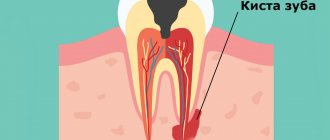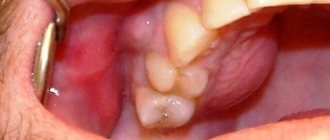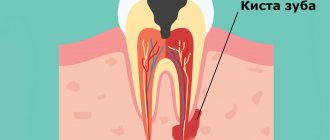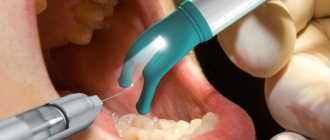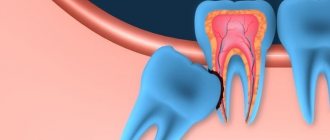How does a tooth root cyst appear?
The causes of cysts are varied, and among them it is impossible to single out the prevailing ones. So, this may be the result of physical trauma to the maxillofacial bones, or a rare but common medical error, in which the tightness of the root canal was broken, which became the basis for the emergence of a source of infection. A similar situation occurs when a dental crown is installed incorrectly. But the reasons for cyst formation are not limited to this. Untreated infectious diseases (in particular, sinusitis or periodontitis) are no less a provoking factor.
Classification of dental cysts
There are not many types of cysts, so understanding them is not difficult. Four main types are distinguished by location:
- wisdom tooth cyst;
— a cyst due to an illiterate (unprofessional) installed dental crown;
- a cyst that arose as a result of the influence of a third-party infectious disease (sinusitis);
- a cyst localized in the area of the front teeth.
At the same time, a classification is used based on previous circumstances preceding the occurrence of the cyst:
- a disease caused by poor-quality removal of one or more teeth;
— periodontal type cyst, provoked by an inflammatory process in the gums;
- a cyst caused by the growth of a wisdom tooth (retromolar or paradental);
- a cyst that occurs in children, first during the period of the appearance of milk (follicular) teeth, and then molars (eruption cyst);
— a cyst that arose as a complication of periodontitis (radicular);
— a situation is also possible in which the tissue forming the tooth degenerates (keratocyst).
Diagnosis of symptoms of tooth root cyst
The appearance of a cyst implies the formation of a cavity, which gradually grows while simultaneously filling with pus. This condition can last for a long time, and the patient does not experience pain. A sign suggesting the presence of a cyst is slight pain that occurs when pressing on the gum. Such a symptom only in rare cases becomes a reason to visit a dentist. Basically, it occurs in later stages, when the pain intensifies and becomes nagging, continuous, cannot be relieved with analgesics, and inflammation begins to additionally manifest itself in the form of swelling and swelling of the gums in combination with a persistent unpleasant odor in the oral cavity. Finally, a situation cannot be ruled out in which a fistula occurs - that is, a channel through which the contents of the cavity independently come out.
An effective way to detect a cyst in a timely manner is to conduct an X-ray examination followed by its opening and removal.
It should be noted that at the very beginning the disease poses minimal danger to surrounding tissues, since the cavity itself is reliably isolated by thick walls. However, as pus accumulates, the pressure on the walls increases, creating the possibility of a breakthrough, which can lead to blood poisoning and, in the long term, damage to the structure of the jaw bones. At the same time, the dynamics of cyst development are unpredictable and strictly individual. However, in the presence of other inflammatory processes or infections, in a weakened body the transition to the acute stage can occur quickly.
Particular attention should be paid to early diagnosis of the disease in pregnant women. This is due to the complexity of treatment: during pregnancy, only stabilization of the cyst is possible. If the inflammatory process worsens, the choice of treatment methods is strictly limited. That is why, at the planning stage of pregnancy, it is necessary to undergo a full examination by a dentist.
Operation stages
- Removing a tooth with a cyst. Carefully separate the tooth from the supporting ligaments and extract it using an ultrasonic scalpel. At the same time, the bone tissue around the root and cyst is preserved.
- Treatment of bone tissue Ultrasonic cleaning of bone from overgrown cystic structures and antiseptic treatment. Control inspection of the hole under optical magnification.
- Filling the cavity formed in the bone In the absence of suppuration from the bone cells, the void formed by the cyst is filled with a bone tissue growth stimulator.
In cases where, after the removal of a tooth with a cyst, increased suppuration is observed, the hole is drained and left open. After complete relief of inflammation, the hole is filled with bone material (preservation). But in some cases (especially young patients), natural bone growth occurs during this time and the use of osteomaterials is not required.
Tooth root cyst in children
The disease has features and varieties that are characteristic strictly for children. First of all, we are talking about formations that arise and go away on their own, without complications: in the form of a rash that appears on the gums, as well as the so-called “Epstein’s pearl”. Both varieties do not pose a danger due to the absence of purulent masses, which means that the cavity is infected. In addition, they may not occur at all, being only some of the phenomena accompanying the development of the child.
The situation is different with the appearance of a cyst during the growth of teeth (both milk and molars). In this case, the resulting cavities are infected, and given the previously described asymptomatic nature of the disease in the early stages, the most reliable method of determining its presence is regular visits to the doctor. This allows for successful treatment at the very beginning of the development of the cyst, saving the tooth in almost 100 percent of cases.
Risks of immediate implantation
The one-stage protocol involves the implantation of an implant immediately after tooth extraction, into the hole left after it. This method eliminates the need to wait for bone tissue to recover. But after removing a tooth with a cyst, inflammation in the surrounding tissues always remains. Therefore, the risk of installing a sterile implant in pus is almost one hundred percent .
The root cyst is combined with a jaw bone defect. Under such conditions, it is impossible to ensure the stability of the implant. The probability of developing peri-implantitis with implant rejection is close to 100% . The risk of inflammation spreading beyond the primary focus increases.
Clinical cases that served as the prototype for this experimental treatment were demonstrated at several surgical conferences. But in a detailed analysis of the facts of “ideal results” of long-term observation of patients, external information independently received and processed by us cannot be considered reliably confirmed by us.
We do not conduct experiments on our patients!
We work on the principles of quality medicine, provide a lifetime guarantee for implantation , therefore we have no right to risk the health of our patients. The method of installing an implant immediately after removing a tooth with a cyst is not used in the Center until successful and confirmed results of such treatment are obtained.
Levin Dmitry Valerievich Chief physician and founder of the Doctor Levin center
I advise patients who have read marketing articles on the Internet about the benefits of instant removal and instant installation of dental implants directly into the sockets to be more relaxed about such proposals. Taking antibiotics for a month and being afraid is worse than taking a break for a month, recovering and performing a sterile operation without risk.
Don't let fears of long-term treatment take precedence over common sense! Many people, due to fear, tend to make quick, but not entirely correct, decisions. I kindly ask you to take the time to carefully study the guarantees section in the contract. No clinic will undertake an indefinite obligation to provide such a service. You may find yourself in a difficult situation when such an experiment fails.
Undoubtedly, this technique is an interesting new technology, but it requires additional monitoring for several more years.
Methods for treating dental cysts
As mentioned earlier, the only reliable and error-free method for diagnosing a cyst on the root of a tooth is an x-ray. In most cases, one x-ray is sufficient; however, due to individual tooth growth patterns, an additional x-ray of the root portion may be required.
Based on the analysis of X-ray data, the dentist determines and prescribes the type of treatment. Due to the difficulty of accessing the cavity, the process of getting rid of the cyst can take several sessions - however, only this method allows you to eliminate the pathology while keeping the tooth itself healthy.
There are two main directions of treatment: therapeutic and surgical.
— the sequence of actions during therapeutic treatment is as follows: the dentist gains access to the intradental canals (to do this, the tooth tissue is opened), expands them, cleans the cavity from pus, then disinfects it and installs a temporary filling. In the absence of relapse and a favorable outcome, the temporary filling is replaced with a permanent one. An alternative option may be the depophoresis method. Its difference is that the cleaning of the canals occurs due to the sequential introduction of a special substance into them, which, under the influence of an electric current, disinfects them. The common property of both methods is their applicability in the early stages of the disease;
— surgical intervention is used in most cases due to its reliability and high efficiency. There are three types of surgical treatment: cystectomy, hemisection and cystotomy. The first option involves opening the gum from the side and removing the cyst, followed by suturing. Rehabilitation takes place while taking antibiotics. Hemisection requires additional removal of the affected tooth root and crown fragment. If a cystotomy is prescribed, penetration into the cavity is carried out through the near wall. This method has a significant rehabilitation period.
In addition to the above methods, laser therapy is used. Its principle of operation is to insert a thin tube into the cyst, allowing complete disinfection using a laser, followed by vacuum cleaning. This progressive method is painless and effective, since it is guaranteed to preserve the tooth and protect against recurrence of pathology.
Rehabilitation period and prevention of dental cysts
Due to the fact that the cyst is an inflammatory infectious process, drug therapy necessarily includes taking antibiotics, which are selected by the attending physician. Vitamin complexes and immunomodulators act as compensating medications. Treatment of dental cysts with medications is carried out simultaneously with removal of the cyst.
The main ways to avoid the disease are to regularly visit the dentist and carefully monitor oral hygiene. For preventive purposes, you can periodically rinse with infusions and decoctions - for example, aloe, calendula, sage. Combined with strict adherence to the dentist’s recommendations and timely relief from chronic nasopharyngeal diseases, this will ensure dental health for years to come.
You also need to clearly understand that a cyst on the root of a tooth is one of the serious and complex diseases, the treatment of which requires time and highly qualified surgeons. Only this guarantees the absence of complications: re-infection, the occurrence of an abscess, pulpitis or fistula, damage to adjacent tissues and teeth.
PiezoSurgery® protocol - gentle ultrasonic tooth extraction
Ultrasound surgical system with NSK VarioSurg 3 optics minimizes trauma
- Gentle work on bone tissue and soft tissue
- Fractures of the walls of the alveolar ridge are excluded
- The device turns off when it touches soft tissues, preventing damage to the cyst shell



